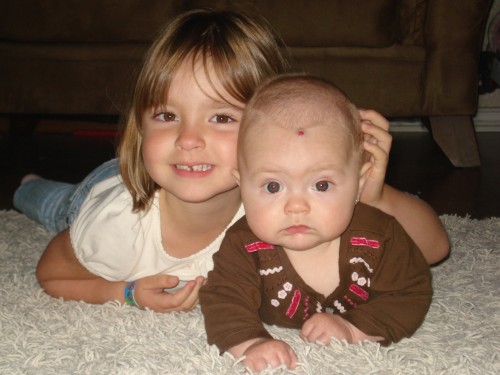There’s no way to know, for sure, which of Blythe’s special needs were caused by meth exposure. It’s very possible that some of them would have occurred anyway, regardless of meth’s presence in her life.
The drastic improvements, though, tell me that at least some of them could be common among meth exposed kids, and so I’m going to discuss each of them, and the things that helped us to cope with them, one post at a time.
CSF Pockets:
Until recently, Blythe had two lumps on her head that were pockets of Cerebrospinal Fluid, trapped between her scalp and her skull.
Most of the time, they weren’t noticeable to anyone who wasn’t looking for them, although they would often swell with major changes to the barometric pressure in her environment.
Any time the pockets would expand, or if the one closest to the base of her skull would shift to the area directly above her spinal cord, she would get terrible CSF headaches. A lot of times she would just be especially cranky during the day, but when she would lay down to sleep at night, the pressure would become extreme and cause her an immense amount of pain.
There were also times when the pressure from the lumps would cause her to have some random symptoms of neurological problems, such as blanking out for short periods of time, or aphasia, where she would use the wrong words for things without realizing her mistakes.
One time, she asked repeatedly for “Bar-be-que” and got very upset with me for not bringing her the ice she was asking for. Good times!
Managing the CSF pockets was all about preventative maintenance in the form of daily therapy. The first step was to locate the pockets, which was fairly easy given that I could feel the lumps with my hands. Sometimes heads are just naturally lumpy, though, so to confirm that a particular lump was a pocket of CSF fluid rather than anything else, I used what I refer to as The Reverse Stud Finder Test.
With the pointer and middle fingers pressed firmly together, a firm tap to the head would normally sound solid, as it would when tapping a stud. A tap landing on a pocket of CSF, however, sounds hollow, the way a wall sounds between studs.
The daily therapy involved tapping the lumps, off and on, for about ten to fifteen minutes. When I kept up with the therapy, the taps didn’t hurt at all, and would actually release endorphins that put Blythe in an incredibly good mood when the session was over.
If I skipped days, though, or if the lumps had expanded for some reason, the initial taps were painful and she fought them. I’ve been smacked, punched and yelled at more than a few times. What I would typically do, in that situation, was to engage her in some sort of activity and do one tap every few minutes until the pressure dissipated and she stopped protesting.
Most of the time, whenever I told Blythe it was time for taps, she would climb into my lap and allow me to do the therapy without any problems. Occasionally, she would even ask me to do her taps, or would grab my hand and guide it to her head.
It’s strange for me, now, to massage her head and not feel those familiar lumps that were a daily part of our lives for so long. I still watch for them, just in case, but it seems that they have disappeared along with so many of her other symptoms.
